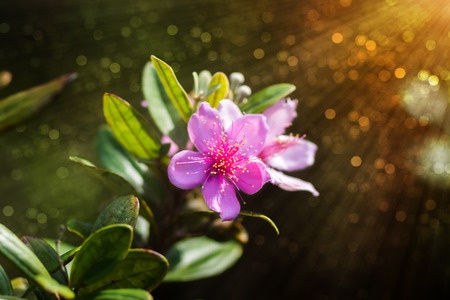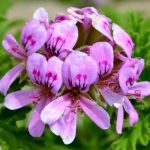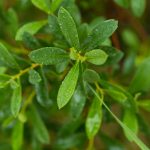
Downy Rose Myrtle or Rhodomyrtus tomentosa (Aiton) Hassk. (Family: Myrtaceae) is a flowering plant that could provide product developers with a rich source of colour. This supplements its culinary uses. It is found native to much of southern Asia, India to Malaysia and China. It prefers wet bog and other moist tropical areas. I’ve seen it grown in Singaporean gardens and also provides a sweet fruit mainly used in jams and jellies. It is also an invasive species in Hawaii and Florida which is understandable given its growth preferences.
A recent article identifies the major anthocyanins (Cui et al., 2013). The extraction followed typical methodology whereby the pigments were extracted with 1% TFA in methanol. Then purified on a X-5 resin column and C-18 SPE) cartridge. Using semi-preparative HPLC (high performance liquid chromatography) and a Sephadex LH-20 column for chromatographic purification and then HPLC-ESI/MS (electrospray ionization- mass spectroscopy) coupled to NMR (nuclear magnetic resonance spectroscopy), the anthocyanins were purified further to reveal 3-O-glucoside forms of cyanidin, peonidin, malvidin, petunidin, pelargonidin and delphinidin. As is typical with many pigmented fruits, the cyanidin was the most abundant, forming 29.4 mg/100g dry weight and the extract showed good antioxidant potential.
It is also used in Thai medicine to treat gastrointestinal, urinary tract infection and oral infections. Ethanolic extracts of the leaf have also been tested to some success against Streptococcus pyogenes and Gram-Positive bacteria (Limsuwan et al., 2009, 2012; Sianglum et al., 2011). The active agent is Rhodomyrtone. This agent has also been tested against acne vulgaris, generally caused by a range of Staphyloccocal species and Propionibacterium acnes. The Rhodomyrtone was encapsulated into liposomes to form a relatively effective topical treatment for this skin condition (Chorachoo et al., 2013). It’s evident that this myrtle offers potential in the treatment of a number of conditions and could be incorporated successfully into topical creams. Two phloroglucinols have also been extracted- Tomentosone A and B which are claimed to have action against the malarial parasite Plasmodium (Hiranwat et al., 2012).
Revised 23rd Jan. 2013
References
Chorachoo, J., Thanaporn A., Supayang P. V. (2013) Liposomal Encapsulated Rhodomyrtone: A Novel Antiacne Drug. Evidence-Based Complementary and Alternative Medicine. Vol. 2013, Article ID 157635, http://dx.doi.org/10.1155/2013/157635
Cui, C., Zhang, S., ren, J., Luo, W., Chen, W., Zhao, M. (2013) Antioxidant capacity of anthocyanins from Rhodomyrtus tomentosa (Ait.) and identification of the major anthocyanins. Food Chem., 139 (1-4) pp. 1-8
Hiranwat, A., Mahabusarakam, W., Carroll, A.R., Duffy, S., Avery V.M. (2012) Tomentosones A and B, Hexacyclic Phloroglucinol Derivatives from the Thai Shrub Rhodomyrtus tomentosa. J. Org. Chem., 77 (1), pp 680–683 DOI: 10.1021/jo201602y
Limsuwan, S., Kayser, O., Voravuthikunchai, S.P. (2012) Antibacterial Activity of Rhodomyrtus tomentosa (Aiton) Hassk. Leaf Extract against Clinical Isolates of Streptococcus pyogenes. Evidence-Based Complementary and Alternative Medicine. Article ID 697183 doi:10.1155/2012/697183
Limsuwan, S., Trip, E.N., Kouwen, T.R.H.M. , (2009) Rhodomyrtone: a new candidate as natural antibacterial drug from Rhodomyrtus tomentosa, Phytomedicine, 16, (6-7), pp. 645–651 6 pages
Saising, J., Ongsakul, M., Voravuthikunchai, S.P. (2011) Rhodomyrtus tomentosa (Aiton) Hassk. ethanol extract and rhodomyrtone: a potential strategy for the treatment of biofilm-forming staphylococci. J. Med. Microb., 60, (12) pp. 1793–1800
Sianglum, W., Srimanote, P., Wonglumsom, W., Kittiniyom, K., Voravuthikunchai, S.P. (2011) Proteome analyses of cellular proteins in methicillin-resistant Staphylococcus aureus treated with rhodomyrtone, a novel antibiotic candidate. PLoS ONE, 6, (2) Article ID e16628
Internet sites on its alien status in the USA: http://plants.ifas.ufl.edu/node/364
Australia: http://www.daff.qld.gov.au/documents/Biosecurity_EnvironmentalPests/IPA-Ceylon-Hill-Cherry-Risk-Assessment.pdf


Leave a Reply